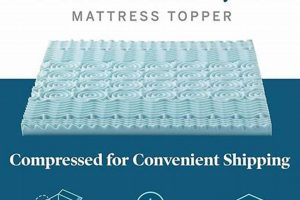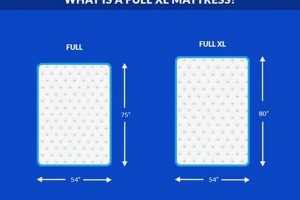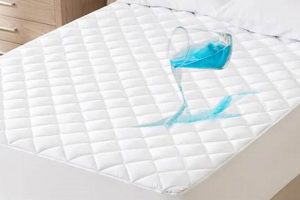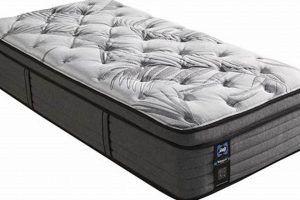The primary difference lies in length. One offers a standard sleeping surface suitable for children and smaller adults, typically measuring around 75 inches long. The other provides an extended length of approximately 80 inches, catering to taller individuals who require additional legroom. For example, a child transitioning from a crib might comfortably fit on the former, while a college student residing in a dorm room may find the latter a more suitable option.
Selecting the appropriate sleeping surface is important for promoting comfortable and restorative sleep. Adequate length prevents discomfort and promotes better spinal alignment. Historically, space limitations in bedrooms, particularly in shared living spaces, have influenced the popularity of these sizes. Furthermore, cost considerations and intended user demographics play a role in purchase decisions.
The following sections will delve into a detailed comparison, exploring dimensions, space requirements, suitability for different age groups, common uses, and ultimately, factors to consider when selecting between the two available options. This information aims to provide clarity and assist individuals in making informed choices based on their specific needs and circumstances.
Tips for Choosing Between the Two Mattress Sizes
Selecting the correct mattress dimensions is crucial for optimizing comfort and space. These tips offer guidance for making an informed decision.
Tip 1: Assess Sleeper Height: Measure the height of the intended user. Individuals taller than 5’8″ may benefit from the added length to prevent feet from hanging off the edge.
Tip 2: Evaluate Room Dimensions: Measure the available space in the bedroom. The extended length requires slightly more floor area. Ensure adequate room for movement and other furniture.
Tip 3: Consider Bedding Availability: Recognize that standard bedding may not fit the longer option. Confirm readily available sheets, comforters, and mattress protectors in the appropriate dimensions.
Tip 4: Anticipate Future Use: Consider the lifespan of the mattress and potential future users. A growing child may eventually require the extra length of one, making it a more versatile long-term investment.
Tip 5: Account for Co-Sleeping: If co-sleeping with pets or small children is anticipated, the wider bed sizes might be a more suitable alternative.
Tip 6: Budget Accordingly: The longer alternative can sometimes have a higher price point. Factor in the cost of the mattress and associated bedding when determining affordability.
Tip 7: Prioritize Comfort: If possible, test both sizes to determine which provides the most comfortable and supportive sleeping experience. Lie on each mattress in various positions to assess spinal alignment and pressure points.
By considering these factors, one can more confidently choose the dimensions that best align with individual needs, spatial constraints, and budgetary considerations.
The concluding sections will summarize the key differences and provide a final recommendation based on various common scenarios.
1. Length
Length is the defining characteristic distinguishing these two mattress types. This dimensional difference significantly impacts suitability for various individuals and spatial requirements.
- Standard Twin Dimensions
The standard twin mattress measures approximately 75 inches in length. This dimension is generally well-suited for children, adolescents, and adults below a certain height threshold, typically around 5’5″ to 5’7″. Its compact length allows it to fit comfortably in smaller bedrooms or shared spaces, such as children’s rooms or bunk beds.
- Extended Twin XL Dimensions
The twin XL mattress features an extended length of approximately 80 inches. This added length caters specifically to taller individuals, providing ample legroom and preventing discomfort caused by feet hanging off the edge of the bed. This makes it a popular choice for college dormitories and guest rooms accommodating adults of varying heights.
- Impact on Comfort and Sleep Quality
Insufficient length can lead to restless sleep, as individuals may unconsciously adjust their position to avoid their feet extending beyond the mattress edge. The extended length of the twin XL promotes better spinal alignment and reduces pressure points, potentially improving overall sleep quality for taller individuals.
- Space Optimization Considerations
While the extended length offers comfort benefits, it also necessitates careful consideration of available space. The added five inches requires slightly more floor area, which can be a significant factor in smaller rooms. Therefore, assessing room dimensions is crucial before deciding between the two options.
In essence, length is the core differentiator, influencing user comfort, space utilization, and overall suitability. The selection process should prioritize individual height requirements and a thorough evaluation of the available bedroom space to ensure an optimal sleep environment.
2. Space Requirements
Mattress selection is directly influenced by available square footage. Standard mattresses typically measure 38 inches wide by 75 inches long. An extended mattress maintains the 38-inch width but increases the length to 80 inches. This seemingly small five-inch difference can have a notable impact on room layout and functionality, particularly in smaller bedrooms or shared living spaces. The extended mattress requires more unobstructed floor area, affecting the placement of other furniture, such as nightstands, dressers, and desks.
Consider, for example, a typical college dormitory room. Space is often at a premium, and the decision to equip rooms with extended mattresses necessitates careful planning to ensure students have adequate space for studying and storage. In such cases, the benefits of accommodating taller students’ comfort must be weighed against the reduction in usable floor space. Similarly, in a child’s bedroom, a standard mattress may be preferred to maximize play area. This trade-off between comfort and spatial efficiency is a crucial factor in mattress choice.
Ultimately, determining spatial constraints is an initial step when choosing between the two options. Failure to account for room dimensions can lead to furniture overcrowding and a compromised living environment. Therefore, assessing the room’s layout and intended use, along with the specific dimensions of each mattress type, ensures a harmonious balance between comfort and efficient space utilization.
3. User Height
User height is a primary determinant in selecting between the standard and extended-length mattresses. The standard dimensions, typically 75 inches, may be suitable for individuals up to approximately 5’7″ or 5’8″. Exceeding this height threshold often results in compromised sleep posture, as legs may extend beyond the mattress edge, leading to discomfort and disrupted sleep cycles. Conversely, the extended-length option, at approximately 80 inches, caters specifically to taller individuals, providing adequate support and preventing the aforementioned discomfort. A practical example is the standard practice in college dormitories, where the extended-length mattress is favored due to the wide range of student heights. User height, therefore, acts as a crucial filter, ensuring the selected mattress adequately accommodates the sleeper’s physical dimensions.
Ignoring user height considerations can have tangible negative consequences. A taller individual forced to sleep on a shorter mattress may experience chronic back pain or restless sleep due to the need to contort or curl up to fit within the available space. This, in turn, can affect daytime cognitive function, productivity, and overall well-being. Conversely, selecting an extended mattress for a significantly shorter individual presents no detrimental health effects but may be an unnecessary expense. The practical significance of understanding this connection lies in making informed purchasing decisions that prioritize both comfort and cost-effectiveness. Healthcare professionals often advise selecting sleeping surfaces that adequately support spinal alignment based on an individual’s unique physical attributes, highlighting the medical importance of this consideration.
In summary, user height is a key element when comparing mattresses. It directly impacts sleep quality and physical comfort. Accurate assessment of height, combined with an understanding of the dimensional differences between the two mattress types, is essential for effective decision-making. The challenge lies in accurately determining the appropriate length, considering both current height and potential growth, especially in the case of younger users. Adhering to these guidelines ensures the selected mattress promotes restorative sleep and long-term physical well-being.
4. Bedding Costs
The selection of a sleeping surface often extends beyond the initial mattress purchase, encompassing the recurring expense of appropriate bedding. The dimensional differences between mattress options directly influence the cost and availability of suitable linens.
- Initial Bedding Set Purchase
The extended-length mattress typically requires specialized bedding, which may be more expensive than standard sizes. Starter bedding sets, including sheets, comforters, and mattress protectors, often carry a premium for the non-standard dimensions. This initial investment should be factored into the overall cost assessment.
- Replacement and Variety of Linens
Standard-sized bedding is widely available from numerous retailers, resulting in competitive pricing and a greater selection of styles and materials. Conversely, the extended mattress may limit purchasing options and potentially increase replacement costs due to specialized sizing.
- Durability and Lifespan of Bedding
The cost-effectiveness of bedding is not solely based on initial price but also on its durability. Higher-quality linens, regardless of size, often provide a longer lifespan and superior comfort, ultimately reducing long-term expenses. The added stress of ill-fitting sheets on a non-standard mattress can decrease the lifespan of standard sheets.
- Specialty Items and Customization
Unique bedding requirements, such as hypoallergenic materials or specific thread counts, can further impact costs. Custom-made bedding tailored to the exact dimensions of the longer mattress may be significantly more expensive than off-the-shelf options for the standard mattress.
In summary, bedding costs represent a recurring financial consideration when evaluating mattress choices. While the initial mattress price is a key factor, understanding the ongoing expense of appropriate linens, their availability, and durability is crucial for making a well-informed decision that aligns with both budgetary constraints and long-term needs.
5. Intended Use
The intended use case directly dictates the optimal sleeping surface dimensions. A child’s bedroom, for instance, typically necessitates a standard size mattress due to space constraints and the child’s physical stature. Conversely, college dormitories frequently utilize the extended version to accommodate a diverse range of student heights, prioritizing comfort and adequate legroom for taller individuals. The direct effect is a more comfortable sleep experience tailored to the user’s physical dimensions and spatial environment. The importance of intended use lies in its capacity to guide purchasing decisions, ensuring alignment with both user needs and practical limitations. Selecting a mattress without considering its intended application can result in spatial inefficiencies or compromised user comfort. A guest room intended for occasional use by varying individuals, for example, may benefit from the extended size to accommodate taller visitors, whereas a daybed might only require the standard size to fit properly in the space.
Furthermore, the intended application influences bedding selection and overall cost considerations. A summer camp bunk, for instance, equipped with standard mattresses, can readily utilize readily available and cost-effective bedding options. In contrast, a rehabilitation facility designed for longer-term patient stays and potentially housing taller individuals might invest in extended mattresses and specialized bedding to promote patient comfort and recovery. Home usage cases vary, from children’s rooms, guest rooms, and daybeds to small rooms that require these mattresses. Proper dimensions of mattresses make a positive impact.
In summary, the intended use case serves as a foundational element in the decision-making process. It establishes a framework for evaluating physical dimensions, spatial limitations, budgetary constraints, and user comfort, thereby guiding individuals towards a well-informed selection. Overlooking the intended application can lead to suboptimal outcomes, including inefficient space utilization, compromised user comfort, and increased long-term costs. The challenge lies in accurately anticipating future needs and usage patterns to select the most versatile and practical mattress option.
Frequently Asked Questions
The following addresses common inquiries regarding the distinctions between standard and extended-length mattress options.
Question 1: Is the extended-length mattress simply a longer version of the standard?
Yes. The primary difference lies solely in the length. The width remains consistent, but the extended version provides an additional five inches in length, catering to taller individuals.
Question 2: Is bedding interchangeable between the two sizes?
No. Bedding designed for one size will not properly fit the other. Using standard bedding on the longer version results in insufficient coverage, while using extended-length bedding on the standard may create excess material and discomfort.
Question 3: Are extended versions more expensive than their standard counterparts?
Generally, yes. Due to the additional material and potentially lower production volumes, the longer version often carries a slightly higher price point.
Question 4: Is the extended version only suitable for college dormitories?
No. While prevalent in dormitories, the extended length is appropriate for any individual who requires additional legroom, regardless of age or setting.
Question 5: Does the extended mattress require a specialized bed frame?
Yes, it does. Standard bed frames are not compatible with this dimension. A frame designed for the extended length is required to provide adequate support.
Question 6: Will the extended version fit in my room if a standard version barely fits?
Probably not. The additional five inches in length can significantly impact spatial arrangements in smaller rooms. Carefully measure the available space before making a purchase.
In summary, the selection requires careful consideration of physical dimensions, spatial limitations, and budgetary constraints. Accurate assessment of individual needs ensures an informed decision.
The subsequent section offers a conclusive overview and final recommendations based on various scenarios.
Conclusion
This exploration of twin mattress vs twin xl mattress underscores the importance of carefully considering dimensions, spatial constraints, and user needs. The defining factor is length; a standard option measures 75 inches, while its extended counterpart reaches 80 inches. This five-inch difference significantly impacts suitability based on user height and available room space. Furthermore, bedding availability and cost must be factored into the decision-making process. Intended use cases, ranging from children’s rooms to college dormitories, further influence the optimal choice.
Selecting the appropriate sleeping surface is an investment in sleep quality and overall well-being. Prioritize accurate measurements, user characteristics, and long-term needs. Failure to do so may result in discomfort, inefficient space utilization, and increased costs. Therefore, thoughtful consideration of these factors is crucial for ensuring a restorative and comfortable sleep environment.







